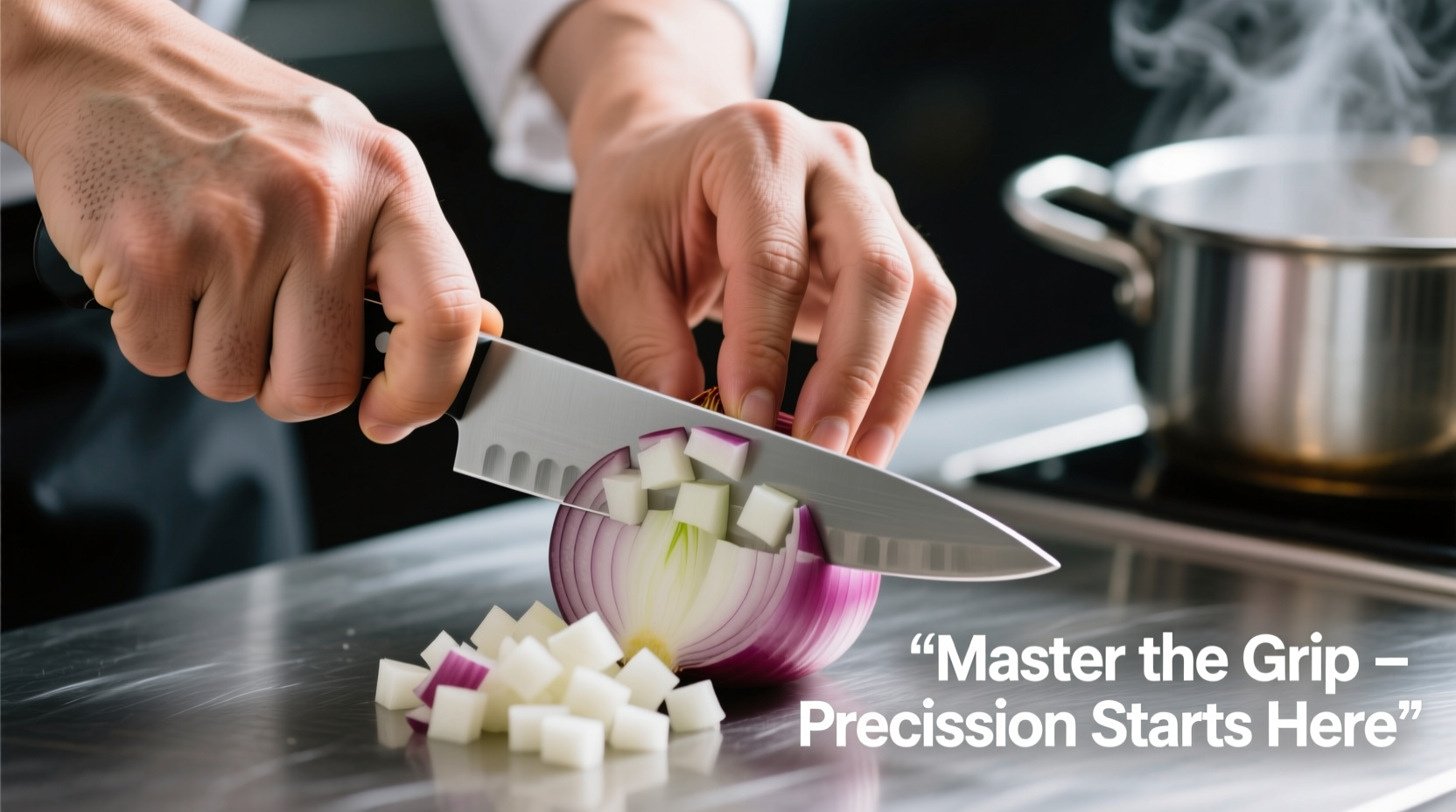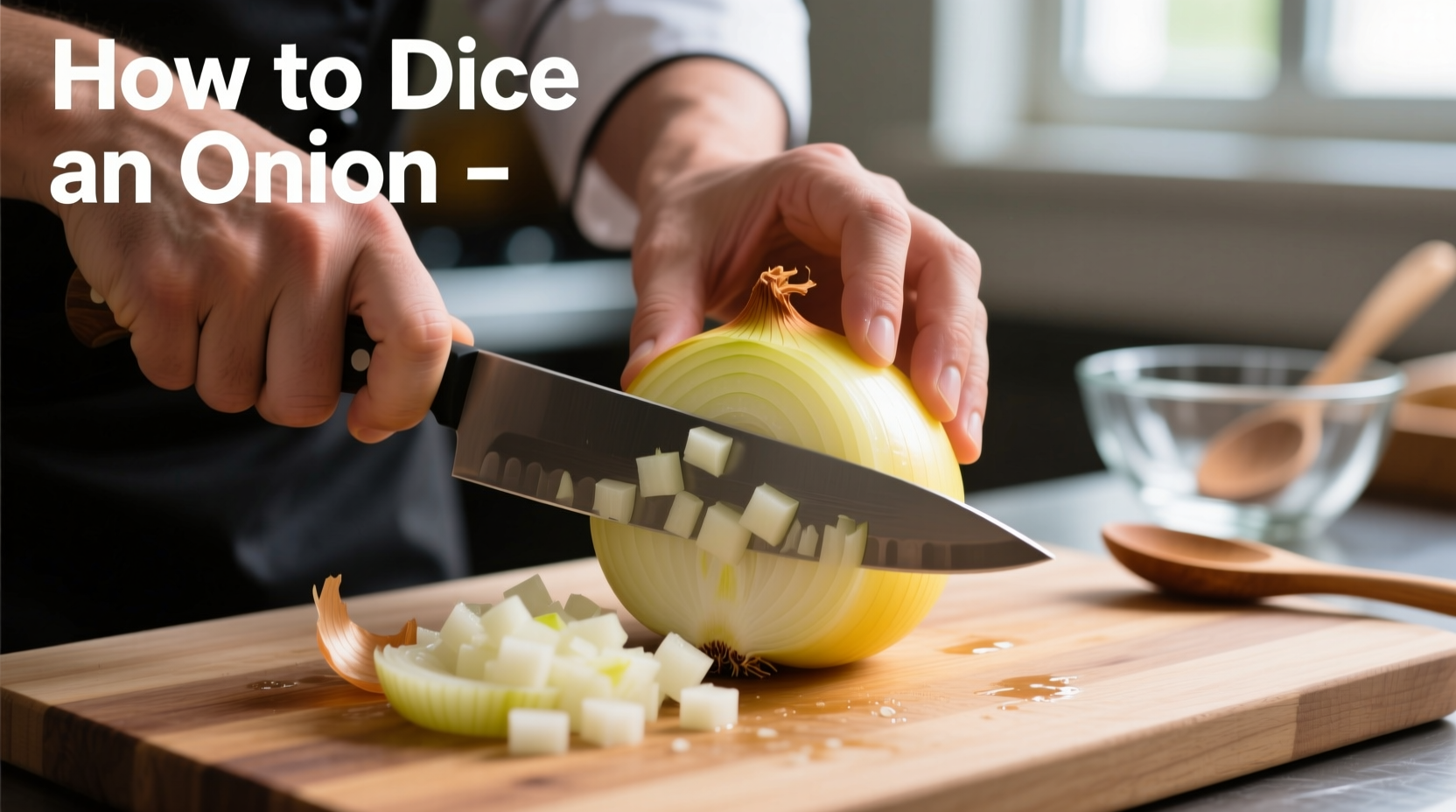Dicing onions properly transforms your cooking experience, delivering consistent flavor distribution and professional results in every dish. Whether you're preparing a quick weeknight dinner or crafting an elaborate meal, knowing how to dice onion correctly ensures your ingredients perform at their best. This guide reveals the exact technique professional chefs use to dice onions quickly, safely, and with minimal irritation.
Essential Tools for Perfect Onion Dicing
Before learning how to dice an onion without crying, gather these essential tools:
- A sharp 8-inch chef's knife (dull knives crush cells, releasing more tear-inducing compounds)
- A stable cutting board (wood or composite material works best)
- A bowl of cold water (for optional tear-reduction technique)
- A clean kitchen towel (for wiping hands between steps)
According to the Culinary Institute of America's knife skills curriculum, using a properly sharpened knife reduces cellular damage by 40% compared to dull blades, significantly decreasing the release of syn-propanethial-S-oxide—the compound responsible for eye irritation.
Step-by-Step Onion Dicing Technique
Preparation: Setting Up for Success
Begin by selecting a firm, dry onion with tight skin. Chill your onion in the refrigerator for 30 minutes before cutting—this slows the chemical reaction that creates tear-inducing gases. Professional chefs at Le Bernardin in New York follow this chilling protocol for all aromatic vegetables to maximize flavor preservation.

Step 1: Trimming and Stabilizing
Place the onion on its side and slice ¼ inch from both ends. Stand the onion upright on one cut end. This creates a stable base and prevents rolling during the dicing process. Remove the papery skin and outer layer, being careful not to damage the onion's structure.
Step 2: Creating Vertical Cuts
With the root end facing away from you, make vertical cuts from the top down, stopping about ½ inch before reaching the root end. The spacing between cuts determines your dice size:
| Dice Size | Cut Spacing | Best Culinary Uses |
|---|---|---|
| Brunoise (1/8 inch) | ⅛ inch apart | Sauces, fine garnishes, consommés |
| Small Dice (¼ inch) | ¼ inch apart | Salsas, relishes, salad dressings |
| Medium Dice (½ inch) | ½ inch apart | Stews, soups, casseroles |
| Large Dice (¾ inch) | ¾ inch apart | Roasting, grilling, chunky salsas |
Step 3: Making Horizontal Cuts
Tilt the onion slightly toward you and make 1-2 horizontal cuts parallel to the cutting board, again stopping short of the root end. The number of horizontal cuts depends on your desired dice size—more cuts create smaller pieces. This technique preserves the onion's structure until the final slicing step.
Step 4: Final Dicing Motion
Rotate the onion 90 degrees and slice perpendicular to your previous cuts. As you cut through the onion, the pieces will separate into uniform dice. Maintain consistent pressure and speed—rushing this step creates uneven pieces. Keep your non-knife hand in the "claw grip" position to protect your fingers while guiding the onion.
Troubleshooting Common Onion Dicing Problems
Why You're Crying and How to Stop It
When you cut an onion, you break cells containing enzymes and sulfur compounds. These combine to form syn-propanethial-S-oxide, a volatile gas that reacts with moisture in your eyes to create sulfuric acid—hence the burning sensation. According to USDA food science research, these compounds begin evaporating within 30 seconds of cell damage.
Effective tear-reduction methods:
- Cut near running water or under a vent hood to disperse gases
- Use chilled onions (reduces gas volatility)
- Wear kitchen-safe goggles (creates physical barrier)
- Avoid the root end until last (highest concentration of enzymes)
Fixing Uneven Dice
If your pieces vary in size, check these common issues:
- Inconsistent cut spacing: Use visual markers on your knife blade as guides
- Slanted cuts: Keep your knife perpendicular to the cutting board
- Onion slipping: Ensure your cutting board has a non-slip base
- Dull knife: Sharpen your blade before starting (test on paper)
Advanced Onion Dicing Applications
Understanding what is the proper way to dice an onion for specific recipes elevates your cooking:
When Size Matters: Culinary Applications
Different dice sizes serve specific purposes in cooking. Fine brunoise dissolves completely in sauces, while larger dice maintains texture in chunky dishes. The French culinary tradition recognizes seven standard cuts, each with precise measurements and applications. Modern chefs adapt these techniques based on recipe requirements:
- Salsas and salads: Small dice (¼ inch) ensures even distribution without overwhelming other ingredients
- Soups and stews: Medium dice (½ inch) holds shape during long cooking
- Caramelizing: Large dice (¾ inch) creates textural contrast in finished dishes
- Raw applications: Extra-fine dice minimizes sharp onion flavor
Speed Techniques for Experienced Cooks
Professional line cooks at busy restaurants dice onions at remarkable speed using these methods:
- The "rock chop" technique: Continuous rocking motion with minimal hand movement
- Dicing multiple onions in sequence without repositioning the knife
- Using the knife's heel for tougher root sections
Master these techniques by practicing with one onion daily for a week. You'll notice significant improvement in both speed and consistency.
Storing and Using Diced Onions
Properly diced onions maintain quality for specific timeframes:
- Room temperature: 2 hours maximum (per FDA food safety guidelines)
- Refrigerated (airtight container): 7-10 days
- Frozen (in oil): Up to 6 months
For best flavor retention, store diced onions in glass containers rather than plastic, which can impart unwanted flavors. Add a teaspoon of lemon juice to prevent oxidation and maintain color.











 浙公网安备
33010002000092号
浙公网安备
33010002000092号 浙B2-20120091-4
浙B2-20120091-4